
St Mary's Pro-Cathedral
Encyclopedia
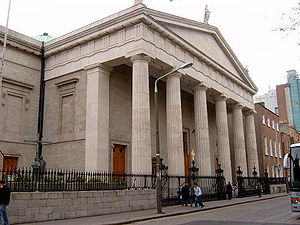
Pro-cathedral
A pro-cathedral is a parish church that is temporarily serving as the cathedral or co-cathedral of a diocese.-Usage:In Ireland, the term is used to specifically refer to St Mary's Pro-Cathedral in Dublin, the seat of the Roman Catholic Archbishop of Dublin since the Reformation, when Christ Church...
and is the episcopal seat of the Roman Catholic Archbishop of Dublin
Archbishop of Dublin (Roman Catholic)
The Archbishop of Dublin is the title of the senior cleric who presides over the Archdiocese of Dublin. The Church of Ireland has a similar role, heading the United Dioceses of Dublin and Glendalough. In both cases, the Archbishop is also Primate of Ireland...
and Primate of Ireland
Primate of Ireland
The Primacy of Ireland was historically disputed between the Archbishop of Armagh and the Archbishop of Dublin until finally settled by Pope Innocent VI. Primate is a title of honour denoting ceremonial precedence in the Church, and in the Middle Ages there was an intense rivalry between the two...
.
Status as "pro-cathedral"
The city of Dublin possesses two cathedrals, but unusually, both belong to one church, the minority Church of IrelandChurch of Ireland
The Church of Ireland is an autonomous province of the Anglican Communion. The church operates in all parts of Ireland and is the second largest religious body on the island after the Roman Catholic Church...
, which up until 1871 had been the religion of establishment in Ireland. In contrast, the majority religion in Ireland, Roman Catholicism, has no cathedral in Ireland's capital city and has not had one since the Reformation
Protestant Reformation
The Protestant Reformation was a 16th-century split within Western Christianity initiated by Martin Luther, John Calvin and other early Protestants. The efforts of the self-described "reformers", who objected to the doctrines, rituals and ecclesiastical structure of the Roman Catholic Church, led...
, when the bishops in Ireland followed Henry VIII's break from Rome. As the official church, the Church of Ireland took control of most church property, including the Cathedral of the Holy Trinity
Christ Church Cathedral, Dublin
Christ Church Cathedral is the cathedral of the United Dioceses of Dublin and Glendalough and the cathedral of the Ecclesiastical province of the United Provinces of Dublin and Cashel in the Church of Ireland...
(generally known as Christchurch) and St. Patrick's Cathedral
St. Patrick's Cathedral, Dublin
Saint Patrick's Cathedral , or more formally, the Cathedral of the Blessed Virgin Mary and St Patrick is a cathedral of the Church of Ireland in Dublin, Ireland which was founded in 1191. The Church has designated it as The National Cathedral of Ireland...
. These two churches had long shared the role of cathedral of Dublin, controversially at first, then under an agreement of 1300, Pacis Compositio, which gave Christchurch formal precedence, including the right to enthrone the Archbishop and to hold his cross, mitre and ring after death, but with deceased Archbishops of Dublin to be buried alternately in each of the two cathedrals, unless they personally willed otherwise, and the two cathedrals to act as one, and "shared equally in their freedoms".
Even though Christchurch has been the property of the Anglican church for nearly five hundred years, it is still viewed by the Roman Catholic Church and the Pope
Pope
The Pope is the Bishop of Rome, a position that makes him the leader of the worldwide Catholic Church . In the Catholic Church, the Pope is regarded as the successor of Saint Peter, the Apostle...
as the primary official Dublin cathedral, since it was so designated by the pope at the request of the then Archbishop of Dublin, St. Laurence O'Toole in the 12th century. Until the pope either formally revokes Christchurch's designation (which, given its historic status and significance for Dubliners, is unlikely), or grants cathedral status to another church (which is much more likely), the main Roman Catholic church in Dublin will continue to be the "pro-cathedral" (meaning in effect acting cathedral), a title officially given to St Mary's Church in 1886, though it used that title unofficially since the 1820s.
Origins of "the Pro"
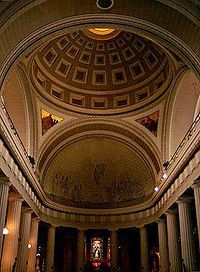
Mass (liturgy)
"Mass" is one of the names by which the sacrament of the Eucharist is called in the Roman Catholic Church: others are "Eucharist", the "Lord's Supper", the "Breaking of Bread", the "Eucharistic assembly ", the "memorial of the Lord's Passion and Resurrection", the "Holy Sacrifice", the "Holy and...
or the sacraments in public and were subject to severe penalties (hence the word penal). While these laws ebbed and flowed in terms of the severity with which they were applied, Catholic churches if they were built at all, were built down narrow, difficult to find roadways. By the early nineteenth century, many of the Penal Laws had either been repealed or were no longer enforced; an unsuccessful attempt had already been made to grant Catholic Emancipation
Catholic Emancipation
Catholic emancipation or Catholic relief was a process in Great Britain and Ireland in the late 18th century and early 19th century which involved reducing and removing many of the restrictions on Roman Catholics which had been introduced by the Act of Uniformity, the Test Acts and the penal laws...
. As a result, Catholicism began to abandon its previous status as an "underground" religion. In 1803, a committee formed by then Archbishop John Thomas Troy
John Thomas Troy
John Thomas Troy was an Irish Dominican and Roman Catholic Archbishop of Dublin....
bought Lord Annesley's townhouse on the corner of Marlborough Street and Elephant Lane (now called Cathedral Street), within sight of the city's premier thoroughfare, Sackville Street
O'Connell Street
O'Connell Street is Dublin's main thoroughfare. It measures 49 m in width at its southern end, 46 m at the north, and is 500 m in length...
(now O'Connell Street) as the location for the planned new pro-cathedral, pending the erection, when funds and the law allowed, of a full Roman Catholic cathedral. The architect
Architect
An architect is a person trained in the planning, design and oversight of the construction of buildings. To practice architecture means to offer or render services in connection with the design and construction of a building, or group of buildings and the space within the site surrounding the...
chosen to execute the design was George Papworth
George Papworth
George Papworth was an English architect who practised mainly in Ireland during the nineteenth century.-Early life and career:Papworth was born in London in 1781 and was the third son of the English stuccoist John Papworth...
. In June 1814 the demolition of the house took place. It was followed by the erection of a new pro-cathedral which combined a number of styles but which externally is closest to Greek revival. Internally, it is more Roman than Grecian. The new Archbishop of Dublin, Daniel Murray
Daniel Murray (archbishop)
Daniel Murray was a Roman Catholic Archbishop of Dublin.He was educated at Dr. Betagh's school, and at Salamanca, and ordained priest in 1790. After some years as curate in Dublin he was transferred to Arklow, and was there in 1798 when the rebellion broke out...
, celebrated the new pro-cathedral's completion on 14 November 1825. It thus became the first Catholic episcopal seat established anywhere in the United Kingdom of Great Britain and Ireland
United Kingdom of Great Britain and Ireland
The United Kingdom of Great Britain and Ireland was the formal name of the United Kingdom during the period when what is now the Republic of Ireland formed a part of it....
since the Protestant Reformation
Protestant Reformation
The Protestant Reformation was a 16th-century split within Western Christianity initiated by Martin Luther, John Calvin and other early Protestants. The efforts of the self-described "reformers", who objected to the doctrines, rituals and ecclesiastical structure of the Roman Catholic Church, led...
.
Though not a full cathedral, the new building became a symbol of the Irish nationalist spirit in the era following the ending of the Penal Laws. Daniel O'Connell
Daniel O'Connell
Daniel O'Connell Daniel O'Connell Daniel O'Connell (6 August 1775 – 15 May 1847; often referred to as The Liberator, or The Emancipator, was an Irish political leader in the first half of the 19th century...
, the leader of Irish nationalism and the first Roman Catholic MP elected to the British House of Commons
British House of Commons
The House of Commons is the lower house of the Parliament of the United Kingdom, which also comprises the Sovereign and the House of Lords . Both Commons and Lords meet in the Palace of Westminster. The Commons is a democratically elected body, consisting of 650 members , who are known as Members...
, was present at a special thanksgiving High Mass in the Pro-Cathedral in 1829 following the granting of Catholic Emancipation
Catholic Emancipation
Catholic emancipation or Catholic relief was a process in Great Britain and Ireland in the late 18th century and early 19th century which involved reducing and removing many of the restrictions on Roman Catholics which had been introduced by the Act of Uniformity, the Test Acts and the penal laws...
, which among other things had allowed Catholics to be elected to parliament. In 1841, as the first Catholic Lord Mayor of Dublin
Lord Mayor of Dublin
The Lord Mayor of Dublin is the honorific title of the Chairman of Dublin City Council which is the local government body for the city of Dublin, the capital of Ireland. The incumbent is Labour Party Councillor Andrew Montague. The office holder is elected annually by the members of the...
in centuries, O'Connell formally celebrated his election by travelling in state to "the Pro" for High Mass. After he died in 1847, his remains were laid in state on a great catafalque in the Pro-Cathedral.
By 2011, some Anglicans were able to acknowledge that
"The forced alienation of sacred places from one community to another leaves lasting scars"
Plans for a full cathedral
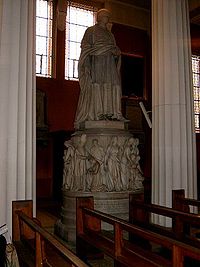
President of the Executive Council of the Irish Free State
The President of the Executive Council of the Irish Free State was the head of government or prime minister of the Irish Free State which existed from 1922 to 1937...
(prime minister) from 1922 to 1932 and a deeply religious Catholic, suggested that the burnt out shell of the General Post Office
General Post Office (Dublin)
The General Post Office ' in Dublin is the headquarters of the Irish postal service, An Post, and Dublin's principal post office...
, the location of the 1916 Rising, be turned into a cathedral, but the idea was not acted on, and the GPO was restored for use as a post office.
John Charles McQuaid
John Charles McQuaid
John Charles McQuaid, C.S.Sp. was the Catholic Archbishop of Dublin and Primate of Ireland between December 1940 and February 1972.- Early life 1895-1914:...
, who served as Archbishop from the 1940s to the early 1970s, bought the gardens in the centre of Merrion Square
Merrion Square
Merrion Square is a Georgian square on the southside of Dublin city centre. It was laid out after 1762 and was largely complete by the beginning of the 19th century. It is considered one of the city's finest surviving squares...
and announced plans to erect a cathedral there, but to the relief of Dubliners, for whom the gardens were an oasis of nature in the centre of a busy city, his plans never came to pass and the gardens were eventually handed over by his successor to Dublin Corporation and opened to the public. While it is suggested periodically that the Church of Ireland, which has a relatively small membership, might hand over one of its cathedrals to the Roman Catholic Church, no serious proposals have been made for such an arrangement. (The Dean of St. Patrick's Cathedral (which serves as the "national cathedral" of the Church of Ireland - Christchurch is the diocesan cathedral of Dublin) did suggest allowing Roman Catholic Masses to be celebrated in his cathedral but the idea was dropped after opposition within the Church of Ireland.) (Anglican opposition was irrelevant, in any case, as the then Catholic Archbishop ridiculed the idea and rejected the Anglican offer out of hand). Though theoretically the possibility of erecting a new Roman Catholic cathedral remains on the agenda, in reality most of the funds collected for the building of a new cathedral have been spent erecting new churches in the rapidly growing archdiocese. As a result, few expect a new cathedral to be erected, with instead the Pro-Cathedral at some stage likely to be raised to full cathedral status, as happened to St Peter's Cathedral, Belfast in the late twentieth century.
State ceremony in the Pro-Cathedral
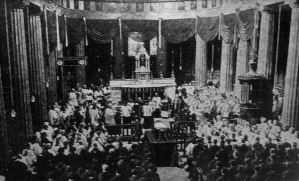
St. Patrick's Cathedral, Dublin
Saint Patrick's Cathedral , or more formally, the Cathedral of the Blessed Virgin Mary and St Patrick is a cathedral of the Church of Ireland in Dublin, Ireland which was founded in 1191. The Church has designated it as The National Cathedral of Ireland...
(if they were members of the Church of Ireland) or the Pro-Cathedral (if they were Roman Catholic). Whereas up to 1973, those ceremonies were exclusively denominational, the ceremonies for the inaugurations of President Childers
Erskine Hamilton Childers
Erskine Hamilton Childers served as the fourth President of Ireland from 1973 until his death in 1974. He was a Teachta Dála from 1938 until 1973...
in 1973, President Ó Dálaigh
Cearbhall Ó Dálaigh
Cearbhall Ó Dálaigh served as the fifth President of Ireland, from 1974 to 1976. He resigned in 1976 after a clash with the government. He also had a notable legal career, including serving as Chief Justice of Ireland.- Early life :Cearbhall Ó Dálaigh, one of four children, was born on 12 February...
in 1974 and President Hillery
Patrick Hillery
Patrick John "Paddy" Hillery was an Irish politician and the sixth President of Ireland from 1976 until 1990. First elected at the 1951 general election as a Fianna Fáil Teachta Dála for Clare, he remained in Dáil Éireann until 1973...
in 1976, were multidenominational, with representatives of the Roman Catholic, Church of Ireland, Presbyterian
Presbyterianism
Presbyterianism refers to a number of Christian churches adhering to the Calvinist theological tradition within Protestantism, which are organized according to a characteristic Presbyterian polity. Presbyterian theology typically emphasizes the sovereignty of God, the authority of the Scriptures,...
, Methodist and the Jewish faith taking part in the ceremony. (In 1973 it took place in St Patrick's, in 1974 and 1976 in the Pro-Cathedral.) In 1983 a multidenominational service was included as part of the civil inauguration in Dublin Castle
Dublin Castle
Dublin Castle off Dame Street, Dublin, Ireland, was until 1922 the fortified seat of British rule in Ireland, and is now a major Irish government complex. Most of it dates from the 18th century, though a castle has stood on the site since the days of King John, the first Lord of Ireland...
.
The major faiths held religious ceremonies in their main cathedral or pro-cathedral to mark the beginning of the law term or a session of parliament, which would be attended by the President of Ireland, the Taoiseach, ministers, the opposition, parliamentarians and members of the Diplomatic Corps. State funerals of major figures including Michael Collins
Michael Collins (Irish leader)
Michael "Mick" Collins was an Irish revolutionary leader, Minister for Finance and Teachta Dála for Cork South in the First Dáil of 1919, Director of Intelligence for the IRA, and member of the Irish delegation during the Anglo-Irish Treaty negotiations. Subsequently, he was both Chairman of the...
and former presidents Seán T. O'Kelly
Sean T. O'Kelly
Seán Thomas O'Kelly was the second President of Ireland . He was a member of Dáil Éireann from 1918 until his election as President. During this time he served as Minister for Local Government and Minister for Finance...
, Éamon de Valera
Éamon de Valera
Éamon de Valera was one of the dominant political figures in twentieth century Ireland, serving as head of government of the Irish Free State and head of government and head of state of Ireland...
and Lord Mayor of Dublin
Lord Mayor of Dublin
The Lord Mayor of Dublin is the honorific title of the Chairman of Dublin City Council which is the local government body for the city of Dublin, the capital of Ireland. The incumbent is Labour Party Councillor Andrew Montague. The office holder is elected annually by the members of the...
Kathleen Clarke
Kathleen Clarke
Kathleen Clarke, née Daly was a member of Cumann na mBan, and one of very few privy to the plans of the Easter Rising in 1916. She was the wife of Tom Clarke and sister to Ned Daly, both of whom would be executed for their part in the Rebellion...
took place there. A painting of the funeral of Michael Collins hangs in Áras an Uachtaráin
Áras an Uachtaráin
Áras an Uachtaráin , formerly the Viceregal Lodge, is the official residence of the President of Ireland. It is located in the Phoenix Park on the northside of Dublin.-Origins:...
, the president's residence.
Physical layout of the Pro-Cathedral
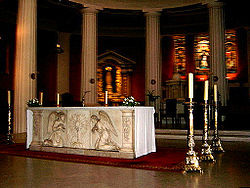
Altar
An altar is any structure upon which offerings such as sacrifices are made for religious purposes. Altars are usually found at shrines, and they can be located in temples, churches and other places of worship...
, behind which a stained glass window of the Blessed Virgin Mary (the Saint Mary of its name) is visible. For most of its existence it possessed a massive Victorian altar and reredos by Turnerelli, a Belfast born sculptor of Italian parentage. In the late 1970s this was removed, as part of a re-ordering to bring its sanctuary in line with changes that followed the introduction of the revision
Mass of Paul VI
The Mass of Pope Paul VI is the liturgy of the Catholic Mass of the Roman Rite promulgated by Paul VI in 1969, after the Second Vatican Council...
of the Mass
Mass (liturgy)
"Mass" is one of the names by which the sacrament of the Eucharist is called in the Roman Catholic Church: others are "Eucharist", the "Lord's Supper", the "Breaking of Bread", the "Eucharistic assembly ", the "memorial of the Lord's Passion and Resurrection", the "Holy Sacrifice", the "Holy and...
. The reredos was completely removed, leaving just the tabernacle
Church tabernacle
A tabernacle is the fixed, locked box in which, in some Christian churches, the Eucharist is "reserved" . A less obvious container, set into the wall, is called an aumbry....
, though the front panel of the original altar was reinstated in the new altar, which was moved to the centre of a new paved area in an expanded sanctuary. The altar rails
Altar rails
Altar rails are a set of railings, sometimes ornate and frequently of marble or wood, delimiting the chancel in a church, the part of the sanctuary that contains the altar. A gate at the centre divides the line into two parts. The sanctuary is a figure of heaven, into which entry is not guaranteed...
were also removed. The pulpit was moved as well, and is currently sitting unused in a corner of the building. A large contingent of Italian artisans were employed by the church, to decorate the interior of the Cathedral.
The Pro-Cathedral caught fire in the early 1990s. Though the fire was extinguished before it caught hold of the building, considerable smoke damage was done to one corner of the building around the monument to Cardinal Cullen, perhaps the most famous of all the nineteenth century Archbishops, and the first Archbishop of Dublin to be made a cardinal.
Organ of the Pro-Cathedral
The original organ in the Pro-Cathedral was built by the Dublin organbuilder, John White, more than one hundred years ago, and the present instrument contains some of White's original pipework. The present facade of the organ dates from William Hill's rebuild of in the organ around 1900. Subsequent work was carried out by Henry Willis & Co. in the 1930s, before J.W. Walker's major rebuild of 1971 under the administrator Monsignor John Moloney and the most recent refurbishment of the instrument, by the same firm which was completed in the autumn of 1995. The newly refurbished instrument was inaugurated in a gala concert given by Olivier Latry on 20 March 1996.Interestingly the swell of the organ is built into the back wall of the Church. The shutters of the swell are in line with the rest of the wall. The organ console itself was moved in a general redevelopment of the church in 1995. This was to facilitate the direction of the choir.
This organ has become regarded as one of the finest examples in Ireland of the late nineteenth-century grand Romantic organ, and has since its original installation featured prominently in the many great liturgical occasions which have graced the pro-cathedral church. More recently many of the great organ recitalists of our time have performed on it: Daniel Chorzempa, Xavier Darasse, Sir David Lumsden, Daniel Roth, Dame Gillian Weir, Arthur Well, Olivier Latry, and others. The current Titular Organist of Saint Mary's Pro-Cathedral is Professor Gerard Gillen
Gerard Gillen
Dr. Gerard Gillen is Professor Emeritus in Music at the National University of Ireland, Maynooth, having retired from the position of Professor and Head of the Music Department of that university at the end of September 2007. He came to NUI Maynooth in 1985, previously having been a lecturer in...
who has held this position since 1971.
A choir organ is located on the epistle (right) side of the High Alter. Since the development of the grand organ it fell into disuse and after some years was closed. It lacks most of its internal pipework and its keyboard. It is characteristic of the earlier period of the Pro-Cathedral.
Music of the Pro-Cathedral
Music has always been a central ministry in Saint Mary's Pro Cathedral. The Palestrina Choir is the resident choir of Saint Mary's Pro-Cathedral. It had its origins in a boys' choir formed in the 1890s by Vincent O'Brien, then a music teacher at St. Mary's Place Christian BrothersCongregation of Christian Brothers
The Congregation of Christian Brothers is a worldwide religious community within the Catholic Church, founded by Blessed Edmund Rice. The Christian Brothers, as they are commonly known, chiefly work for the evangelisation and education of youth, but are involved in many ministries, especially with...
School in Dublin. It was at a performance of Palestrina's Missa Papae Marcelli
Missa Papae Marcelli
Missa Papae Marcelli, or Pope Marcellus Mass, is a mass by Giovanni Pierluigi da Palestrina. It is his most well-known and most often-performed mass, and is frequently taught in university courses on music...
at St. Teresa's Carmelite Church in Clarendon Street in 1898 that this choir came to the attention of Edward Martyn, their founding sponsor. Martyn wished to promote the music of Palestrina which was espoused by Pope Pius X
Pope Pius X
Pope Saint Pius X , born Giuseppe Melchiorre Sarto, was the 257th Pope of the Catholic Church, serving from 1903 to 1914. He was the first pope since Pope Pius V to be canonized. Pius X rejected modernist interpretations of Catholic doctrine, promoting traditional devotional practices and orthodox...
as a standard to which liturgical music should aspire. The Palestrina Choir was constituted and installed in the Pro-Cathedral on January 1, 1903 with O'Brian as director.
In the century since its foundation, the Choir has had seven directors. Vincent O'Brien, director until his death in 1948, was succeeded by his son, Oliver. In 1978, Fr Seán O hEarcaigh took over the baton from Oliver O'Brien. He was succeeded in 1982, by Ite O'Donovan and in 1996 by Comdt Joseph Ryan. Órla Barry was the director from the end of 1996 to 2001. The current director is Blánaid Murphy, who is widely recognised as one of Ireland's pre-eminent choral educators, particularly of children's voices. Over the years the Palestrina Choir has attracted singers of high renown. John McCormack was a member of the Choir from 1904 to 1905. Many recent members are now distinguished soloists, most notably Emmanuel Lawler, who began his singing career as a boy soprano in the Choir. In recent years, the Choir has travelled widely, singing at many cathedrals and venues throughout Ireland, Europe, and North America.
During the school term the Palestrina Choir sing at Sunday morning Solemn Latin Mass (Novus Ordo), Wednesday evening Mass and Friday evening Vespers and Mass. Cantors and visiting choirs frequently assist with the musical liturgy in the pro-cathedral. Another permanent group is the Pro Nuova group, which sings at the Sunday evening Mass.
Burials
- Edward MacCabe, Archbishop of DublinArchbishop of DublinThe Archbishop of Dublin may refer to:* Archbishop of Dublin – an article which lists of pre- and post-Reformation archbishops.* Archbishop of Dublin – the title of the senior cleric who presides over the Roman Catholic Archdiocese of Dublin....
(1879-1885) and CardinalCardinal (Catholicism)A cardinal is a senior ecclesiastical official, usually an ordained bishop, and ecclesiastical prince of the Catholic Church. They are collectively known as the College of Cardinals, which as a body elects a new pope. The duties of the cardinals include attending the meetings of the College and... - Edward Joseph ByrneEdward Joseph ByrneEdward Joseph Byrne was an Irish prelate of the Catholic Church. He served as Archbishop of Dublin from 1921 until his death in 1940.-Biography:...
, Archbishop of Dublin (1921-1940) - John Charles McQuaidJohn Charles McQuaidJohn Charles McQuaid, C.S.Sp. was the Catholic Archbishop of Dublin and Primate of Ireland between December 1940 and February 1972.- Early life 1895-1914:...
, Archbishop of Dublin (1940-1972)

